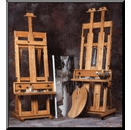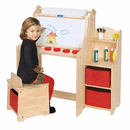For the Beginning Painter: Choosing Acrylics as Your Medium
For the Beginning Painter: Choosing Acrylics as Your Medium
So you’ve decided to try your hand at painting. Many beginning painters sign up for art classes at their local community college. There is also excellent instruction to be found online. As a beginner, you will need to select what kind of paint you will use. The most commonly used paints are acrylics, oils, watercolors and pastels. Each medium has its advantages and disadvantages, and each requires certain tools. Some of the tools you can expect to acquire are: paints, brushes, painting knives, palettes, canvasses, rags, turpentine, mineral spirits, etc. Many beginning artists find it helpful to purchase a painting kit that includes all of the basic tools in one collection.
Acrylics are one of the best choices for beginning painters because they are easy to learn to use, easy to mix and clean up, and have a wide variety of brands that balance cost and quality. The biggest advantage of acrylic paint is that they dry very fast. They can be over-painted without compromising the underlying layers. When used thickly, they mimic oils; when used thinly, they mimic watercolors. Once dry they are water-resistant. Acrylics can also be used like a glue so many mixed-media artists favor them for uses in collages. Brushes used with acrylics can be cleaned with water.
One of the biggest advantages of acrylics is also one of their disadvantages: acrylics dry very quickly. Many artists find this frustrating, although working time may be increased by adding a retarding medium to the paint, or by using a brand that features a longer drying time. Acrylics clean up with water, but they are waterproof so if you wait too long, clean up may become difficult. Also, colors often tend to dry darker than when applied so finding the “right” color may be difficult until you gain more experience using the different pigments. A great acrylic paint kit can be found here: acrylic paint kit.
So you’ve decided to try your hand at painting. Many beginning painters sign up for art classes at their local community college. There is also excellent instruction to be found online. As a beginner, you will need to select what kind of paint you will use. The most commonly used paints are acrylics, oils, watercolors and pastels. Each medium has its advantages and disadvantages, and each requires certain tools. Some of the tools you can expect to acquire are: paints, brushes, painting knives, palettes, canvasses, rags, turpentine, mineral spirits, etc. Many beginning artists find it helpful to purchase a painting kit that includes all of the basic tools in one collection.
Acrylics are one of the best choices for beginning painters because they are easy to learn to use, easy to mix and clean up, and have a wide variety of brands that balance cost and quality. The biggest advantage of acrylic paint is that they dry very fast. They can be over-painted without compromising the underlying layers. When used thickly, they mimic oils; when used thinly, they mimic watercolors. Once dry they are water-resistant. Acrylics can also be used like a glue so many mixed-media artists favor them for uses in collages. Brushes used with acrylics can be cleaned with water.
One of the biggest advantages of acrylics is also one of their disadvantages: acrylics dry very quickly. Many artists find this frustrating, although working time may be increased by adding a retarding medium to the paint, or by using a brand that features a longer drying time. Acrylics clean up with water, but they are waterproof so if you wait too long, clean up may become difficult. Also, colors often tend to dry darker than when applied so finding the “right” color may be difficult until you gain more experience using the different pigments. A great acrylic paint kit can be found here: acrylic paint kit.
Copyright © 2002-2025 Madison Art Shop™ LLC. All Rights Reserved.




















